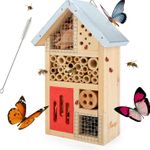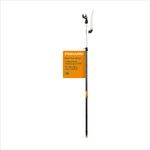Tips to Ensure You’re Getting the Best Plants
A professional shares his secrets for purchasing robust plants

I was standing in front of a group of hollies at my local nursery last fall when Marie, the buyer, came by. “Where were these plants grown?” I asked her. “Oregon,” Marie informed me, “but they’ve been here all season.”
That last statement answered my unasked second question: Had these hollies acclimated to our stifling New York summers?
Learn more: How to Save Money at the Garden Center
Even professionals often fail to account for the stress plants endure when transplanted from, say, the cool summers of the Pacific Northwest to the sweltering summers of the Midwest, South, and Northeast. These Oregon hollies, I now knew, would be fine in my Brooklyn brownstone garden.
Marie’s wholesale nursery is one of the best in the business, so I really needn’t have asked. But 25 years of purchasing plants has inculcated in me a few habits that are hard to break. When I shop for plants, I bring a battery of criteria that I apply before buying even a flat of annuals. And why not? Like any gardener, I want my plants to have the greatest possible chance of success.
So before buying, I evaluate the nursery or garden center; I check the leaves, branches, trunks, and roots of plants; and I ask questions. This method works well for me and may help you with this important step in establishing a garden.
How to evaluate the plant seller
Garden centers versus nurseries
Not every enterprise selling plants is truly a nursery, which is a place where plants are grown. Many garden centers, for example, are really merchandisers. They buy the plants from growers and resell them to you. Both nurseries and garden centers can vary greatly in quality. So before evaluating the plants, consider evaluating the places selling them.
Appearance
Appearance is the first thing you notice about a garden center or nursery, and it is the first indication of quality. Proprietors meticulous about their nursery are probably meticulous about their plants as well. Are the blocks of plants neatly laid out? Are the aisles clear of debris, with few plants lying down or doing poorly? Are the planting pots free of weeds? Some disorder is inevitable, but an untidy appearance overall indicates inattention. When visiting a garden center or nursery, do judge, in part, by its appearance. It is telling.
Prices
After appearance, look at prices. But keep in mind that it is not necessarily low prices that you want to see. If prices are low across the board, buying practices may be based on cost alone. Your evaluation of plants is then particularly important.
Ask questions to determine expertise
Among the most valuable attributes of plant providers are their knowledge and experience, which you learn about only by asking questions. Often a nursery or garden center is run by a horticulturist and staffed by knowledgeable personnel. Find out if anyone on staff is state-certified or has attended horticultural school, and find out what experience they have. If the nursery provides planting services, they most likely purchase quality material and care about the plants they sell.
Try traveling farther afield to find the best
Most of us frequent the nursery or garden center nearest our home, unaware of others not much farther away. Yet they can differ so greatly that we owe it to ourselves to find those that have gone the distance to provide quality and variety. It is a wonderful thing to have a long-term relationship with a nursery you value and with the people who work there. It becomes part of the whole gardening experience, and really, an invaluable part.

How to pick the best plants
Start with the sturdiest specimens
Even at the best nurseries and garden centers, plant quality will vary. Plants of the same species may come from different growers, have been handled or cared for differently, and have individual characteristics. So careful evaluation is important.
Evaluate the plant for form, damage, foliage, blossoms or buds, and new growth
First, look for full form and even development. Check for insect damage and disease, avoiding those with infested, mottled, spotted, or otherwise damaged leaves. Look for abundant foliage with good, rich color. With flowering plants, select those with plenty of well-distributed buds or blossoms. And if plants are already blooming, select those with the clearest, richest hues.
Unless it’s late in the season, check for new growth—the surest indication of inner vitality. A plant out of proportion to its container may be root bound. Feel the pot to see if roots are hard and compacted. All else being equal, select plants in containers free of weeds, as weeds compete with plants for nutrients in the soil.
When selecting annuals, look at the roots
Growers know that color sells, and often dose flats of annuals with fertilizers high in phosphorus and potassium to bring out the bloom in immature plants. We tend to grab the flat showing the most color, but it’s best to look past the blooms and scan the plants for even size and good foliage color.
Also, check how well each plant fills its allotted space. The best annuals are well developed and firmly, but lightly, rooted. Pop a plant from its cell. Ideally, you should see a mix of roots and soil. If you see a solid mass of white, fibrous roots, the plant is too heavily rooted. Some of these roots will need to be cut away before planting, which could set the plant back a bit. If the plant doesn’t pop from the cell and soil spills out, or if the plant seems small in its cell and is completely surrounded by soil, it is probably not sufficiently rooted.

Select shrubs with compact growth
When evaluating a group of shrubs, look for plants that are heavily branched on all sides. Be sure you are comparing plants of the same genus. For instance, a viburnum will carry many more branches than, say, a mophead hydrangea. Generally, the shrub that is more compact is the better grown and has received the most light.
However, size is not always the best indicator of health. It’s important to ask how old the shrub is and where it was grown. A year-old rhododendron grown in the chilly Northeast may be smaller than a year-old rhododendron grown on the balmy West Coast. A locally grown shrub will most likely be the best adapted for your area.
Often shrubs are picked up by the branches and may show some leaf loss from handling. Don’t worry about a few lost leaves as long as the branches are not also split and broken. Some yellowing in the center of a shrub or on the larger leaves is normal. Even broad-leaved evergreens, such as mountain laurel, rhododendron, and the like, do drop leaves. But if it is also close to bloom time, and the buds seem very tight, there may be a problem with the plant.
Look for evenly developed trees
In selecting trees, form is particularly important. The canopy should be attractive and evenly developed, indicating the tree was grown in the open with ample room. Trees grown too close together show one side with dead branches, fewer branches, or no branches at all. Problems in the roots often show up as tip dieback, usually caused by a lack of watering.
If the tree is balled and burlapped, make sure roots have not been damaged by rough handling. If you pull gently on the trunk and the tree moves easily but the root ball doesn’t, or if the root ball is broken, select another tree. Avoid trees with oozing sap, broken branches, recent wounds to the trunk, dull foliage, and fissures in the bark. As with broadleaved plants, some browning and dropped foliage will occur in needled trees. As long as the dropped leaves are accompanied by new shoots, there is no problem.
When selecting perennials, look for new growth
The most important quality to seek in perennials and grasses is an abundance of new growth, which is assurance of a robust plant. Dieback in the center or around the edges of the plant indicates root loss, so look for a plant that’s growing evenly with fresh tips and new shoots.
Perennials and grasses are priced by the container size, which is usually indicative of root growth. Since perennials regrow each year from their roots, this is key. Garden centers sell the plants they buy without repotting them. Nurseries will repot a plant to a larger container when its roots have developed sufficiently and will raise the price accordingly. If the plant seems small for the container, ask the nursery owner if it was transplanted recently. You might as well pay the smaller container price if you are getting a smaller root system.

Put your sixth sense to work
Many years ago when I was working in a greenhouse, a coworker and I were sorting hundreds of pots of the same variety of fuchsia, and one plant caught his attention. “Look at this fuchsia,” he said. “It’s beautiful.” I looked at the plant and, indeed, something about it was extraordinary. It was no larger than its neighbors, but it had vitality—a glow that was unmistakable once noticed. My coworker found this plant with his peripheral perception, a sort of sixth sense we can use in selecting plants.
Since that day, I’ve regularly used peripheral perception to pick out the most vital plants. First, I sort the plants by vigor and condition, then I let my peripheral perception go to work. I scan the plants, then move unhesitatingly toward the one that attracts me the most. Trust this process. I do. Apply the criteria for selecting healthy plants, then turn on your sixth sense to find the best specimens a garden center or nursery has to offer.
Fine Gardening Recommended Products

Ashman Garden Cultivator (1Pack)
Fine Gardening receives a commission for items purchased through links on this site, including Amazon Associates and other affiliate advertising programs.

Niteangel Natural Wooden Insect Hotel, Garden Insect House for Ladybugs, lacewings, Butterfly, Bee, Bug
Fine Gardening receives a commission for items purchased through links on this site, including Amazon Associates and other affiliate advertising programs.

Fiskars 7.9-12ft Extendable 2-in-1 Pole Tree Trimmer & Pruner with Rotating Head and Precision-Ground Steel Saw Blade
Fine Gardening receives a commission for items purchased through links on this site, including Amazon Associates and other affiliate advertising programs.





Comments
Log in or create an account to post a comment.
Sign up Log in